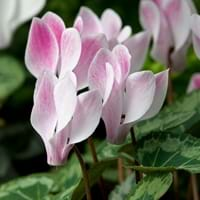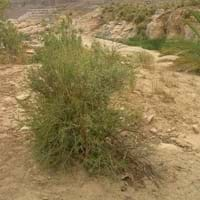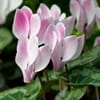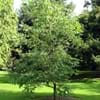Life Span
Perennial
Perennial
Type
Flowering Plants, Tubers
Flowering Plants, Shrub
Origin
Europe, Mediterranean Basin, Middle East, North Africa, Somalia
North Africa
Types
Cyclamen Africanum, Cyclamen Alpinum, Cyclamen Cilicium, Cyclamen Coum
Not Available
Habitat
Alpine Meadows, Rocky areas, Woods
Desert, Rocky Mountains
USDA Hardiness Zone
5-9
Not Available
AHS Heat Zone
7-1
Not Available
Sunset Zone
15, 16, 17, 18, 19, 20, 21, 22, 23, 24
Not Availble
Habit
Clump-Forming
Bushy, Evergreen
Flower Color
Pink, Purple, White
White
Flower Color Modifier
Not Available
Bicolor
Fruit Color
Brown
Black, Blue
Leaf Color in Spring
Several shades of Green
Green, Dark Green
Leaf Color in Summer
Not Available
Dark Green
Leaf Color in Fall
Green, Silver
Green, Dark Green
Leaf Color in Winter
Green, Silver
Green
Leaf Shape
Heart-shaped
Ovate
Plant Season
Autumn, Spring, Summer, Winter
Summer
Sunlight
Indirect sunlight
Full Sun
Type of Soil
Clay, Sandy, Well drained
Clay, Loam, Sand
The pH of Soil
Acidic
Acidic, Neutral
Soil Drainage
Well drained
Moist but well drained
Bloom Time
Autumn, Spring, Summer
Late Summer, Summer
Tolerances
Not Available
Moisture
Where to Plant?
Container, Ground, Pot
Container, Pot
How to Plant?
From bulbs, Seedlings
Seedlings, Semi-hardwood cuttings
Plant Maintenance
Medium
Medium
Watering Requirements
Do not water frequently, It cannot sustain wet-feet, Keep the ground moist but not water-logged, Prefer drip-irrigation instead of Over-head watering, Water when soil is dry
Needs less watering
In Summer
Lots of watering
Ample Water
In Spring
Moderate
Average Water
In Winter
Average Water
Less Watering
Soil pH
Acidic
Acidic, Neutral
Soil Type
Clay, Sandy, Well drained
Clay, Loam, Sand
Soil Drainage Capacity
Well drained
Moist, Well drained
Sun Exposure
Indirect sunlight
Full Sun
Pruning
Cut or pinch the stems, Prune if you want to improve plant shape, Prune ocassionally, Prune to control growth, Prune when plant is dormant, Remove dead leaves, Remove dead or diseased plant parts
Prune after flowering, Prune for shortening long shoots, Remove dead or diseased plant parts
Fertilizers
All-Purpose Liquid Fertilizer
Any balanced general purpose fertilizer
Pests and Diseases
Aphids, Botrytis Cinerea, Gray mold, Mice, Mites, Root weevil, Slugs, Snails, Squirrels
Healthy tree
Plant Tolerance
Drought
Moisture
Flower Petal Number
Single
Not Available
Fragrant Bark/Stem
No
Yes
Foliage Texture
Medium
Fine
Foliage Sheen
Matte
Glossy
Attracts
Not Available
Butterflies
Allergy
Respiratory problems
Not Available
Aesthetic Uses
Showy Purposes
Showy Purposes
Beauty Benefits
Not Available
Acne, Good for skin
Environmental Uses
Air purification
Air purification, Food for birds
Medicinal Uses
Digestive disorders, Menstrual Disorders
Antibacterial, anti-cancer, Antidiabetic, Heart problems, Kidney problems, Respiratory Disorders, Thyroid problems
Part of Plant Used
Root, Stem
Flowers, Leaves
Other Uses
Showy Purposes, Used as an ointment
Used as essential oil, Used in herbal medicines
Used As Indoor Plant
Yes
No
Used As Outdoor Plant
Yes
Yes
Garden Design
Not Available
Container, Edible, Fruit / Fruit Tree, Shade Trees, Tropical
Botanical Name
Cyclamen Persicum
Myrtus nivellei
Common Name
Cyclamen or Florist's Cyclamen
Saharan myrtle
In Hindi
Sikalemen
Saharan myrtle
In German
Zyklamen
Saharan myrtle
In French
Cyclamen
myrte subsaharienne
In Spanish
Ciclamen
mirto subsahariana
In Greek
κυκλάμινο
Σαχάρας μυρτιά
In Portuguese
Cíclame
murta Saharan
In Polish
Cyklamen
mirt Subsaharyjskiej
In Latin
Cyclamīnos
myrto Saharan
Phylum
Anthophyta
Magnoliophyta
Class
Dicotyledonae
Magnoliopsida
Family
Primulaceae
Myrtaceae
Clade
Not Available
Angiosperms, Eudicots, Rosids
Tribe
Cyclamineae
Not Available
Subfamily
Myrsinoideae
Not Available
Season and Care of Cyclamen and Saharan Myrtle
Season and care of Cyclamen and Saharan Myrtle is important to know. While considering everything about Cyclamen and Saharan Myrtle Care, growing season is an essential factor. Cyclamen season is Autumn, Spring, Summer and Winter and Saharan Myrtle season is Autumn, Spring, Summer and Winter. The type of soil for Cyclamen is Clay, Sandy, Well drained and for Saharan Myrtle is Clay, Loam, Sand while the PH of soil for Cyclamen is Acidic and for Saharan Myrtle is Acidic, Neutral.
Cyclamen and Saharan Myrtle Physical Information
Cyclamen and Saharan Myrtle physical information is very important for comparison. Cyclamen height is 0.54 cm and width 0.75 cm whereas Saharan Myrtle height is 200.00 cm and width 200.00 cm. The color specification of Cyclamen and Saharan Myrtle are as follows:
Cyclamen flower color: Pink, Purple and White
Cyclamen leaf color: Several shades of Green
Saharan Myrtle flower color: White
- Saharan Myrtle leaf color: Green and Dark Green
Care of Cyclamen and Saharan Myrtle
Care of Cyclamen and Saharan Myrtle include pruning, fertilizers, watering etc. Cyclamen pruning is done Cut or pinch the stems, Prune if you want to improve plant shape, Prune ocassionally, Prune to control growth, Prune when plant is dormant, Remove dead leaves and Remove dead or diseased plant parts and Saharan Myrtle pruning is done Prune after flowering, Prune for shortening long shoots and Remove dead or diseased plant parts. In summer Cyclamen needs Lots of watering and in winter, it needs Average Water. Whereas, in summer Saharan Myrtle needs Ample Water and in winter, it needs Less Watering.





